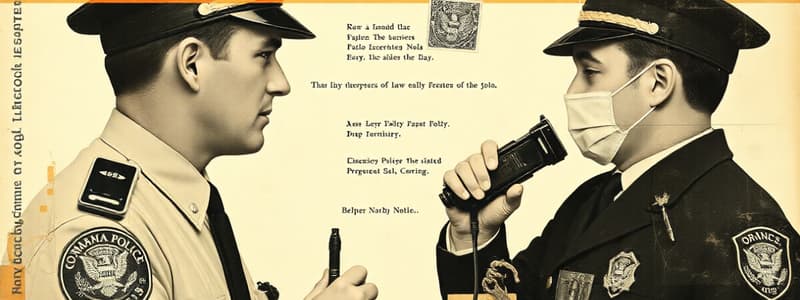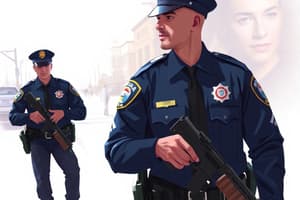Podcast
Questions and Answers
Which entity is responsible for making Terrorist entries into the NCIC Violent Gang and Terrorist Organizational File?
Which entity is responsible for making Terrorist entries into the NCIC Violent Gang and Terrorist Organizational File?
- The National Security Agency (NSA)
- The Federal Bureau of Investigation (FBI) (correct)
- The Central Intelligence Agency (CIA)
- The Department of Homeland Security (DHS)
When an officer requests a record check and the individual is identified as a suspected terrorist, what specific signal will the Information Operator provide in addition to other signals?
When an officer requests a record check and the individual is identified as a suspected terrorist, what specific signal will the Information Operator provide in addition to other signals?
- Signal 44T
- Signal 11T
- Signal 66T (correct)
- Signal 99T
If an officer encounters an individual in Category 1 (Subject of Formal Criminal Charges or Indictments), what immediate action should the officer take after securely detaining the individual?
If an officer encounters an individual in Category 1 (Subject of Formal Criminal Charges or Indictments), what immediate action should the officer take after securely detaining the individual?
- Alert the individual to the FBI's interest.
- Contact the local police precinct.
- Contact the Omaha FBI Field Office at (402) 493-8688. (correct)
- Begin interrogation of the subject.
For individuals in Category 2 (Counter-Terrorism Interest without Formal Charges), what is the primary purpose of detaining the individual?
For individuals in Category 2 (Counter-Terrorism Interest without Formal Charges), what is the primary purpose of detaining the individual?
What is the required action for officers who identify an individual in Category 3 or 4, assuming there is no immediate violation of law?
What is the required action for officers who identify an individual in Category 3 or 4, assuming there is no immediate violation of law?
Besides contacting the Omaha FBI Field Office, what additional action is required for officers who identify an individual in Category 4?
Besides contacting the Omaha FBI Field Office, what additional action is required for officers who identify an individual in Category 4?
Under what circumstances does knowledge of a "Signal X" designation contribute to the justification for a "pat down" search?
Under what circumstances does knowledge of a "Signal X" designation contribute to the justification for a "pat down" search?
What does a "Signal D" designation indicate to officers being dispatched to that address?
What does a "Signal D" designation indicate to officers being dispatched to that address?
What general action should officers take when dispatched to a "Signal D" address before approaching or entering the location?
What general action should officers take when dispatched to a "Signal D" address before approaching or entering the location?
According to the content, what should officers attempt to do when conducting interviews/investigations at a "Signal D" address?
According to the content, what should officers attempt to do when conducting interviews/investigations at a "Signal D" address?
What does Rescue Squad Transportation Code 3 indicate regarding a victim's status?
What does Rescue Squad Transportation Code 3 indicate regarding a victim's status?
When first hitting into service, how may a beat officer identify the area they will be covering?
When first hitting into service, how may a beat officer identify the area they will be covering?
Which series is used for Northeast beat designations?
Which series is used for Northeast beat designations?
Which of the following is NOT specifically listed as a "Signal X" criteria offense?
Which of the following is NOT specifically listed as a "Signal X" criteria offense?
What is the primary purpose of using signals when responding to record checks, according to the OPD policy?
What is the primary purpose of using signals when responding to record checks, according to the OPD policy?
According to the OPD policy, what should an officer do if they need to provide a more detailed explanation after giving a disposition code?
According to the OPD policy, what should an officer do if they need to provide a more detailed explanation after giving a disposition code?
When describing a vehicle, the OPD policy emphasizes which acronym to ensure a specific order of details?
When describing a vehicle, the OPD policy emphasizes which acronym to ensure a specific order of details?
According to OPD policy, what is indicated by the inclusion of "MH" after a code number when communicating via radio?
According to OPD policy, what is indicated by the inclusion of "MH" after a code number when communicating via radio?
According to the OPD policy, what is the significance of 'Signal 66T'?
According to the OPD policy, what is the significance of 'Signal 66T'?
According to the OPD policy, which entity may provide additional limited information on the primary channel during stolen vehicle checks?
According to the OPD policy, which entity may provide additional limited information on the primary channel during stolen vehicle checks?
In the context of OPD radio communication, what does "Bound Over" signify when relayed after a signal?
In the context of OPD radio communication, what does "Bound Over" signify when relayed after a signal?
What does the letter 'L' after the Code Number indicate per OPD policy?
What does the letter 'L' after the Code Number indicate per OPD policy?
Flashcards
Disposition Code
Disposition Code
A code used to describe the outcome of a call, such as "Code 8" for a call to a parent or "Code 7" for an attempt to locate.
CYMMBALS
CYMMBALS
A standardized acronym to remember the order for describing a vehicle (Color, Year, Make, Model, Body Style, Any Other Information, License Plate State, License Plate), used by Omaha Police Department.
Signal System
Signal System
A system used by police to communicate information about a suspect, including their criminal history and potential danger. The "Signal" word distinguishes it from Disposition Codes.
Signal Codes
Signal Codes
Signup and view all the flashcards
Mental Health (MH) Code
Mental Health (MH) Code
Signup and view all the flashcards
LEP Code
LEP Code
Signup and view all the flashcards
Domestic Violence (D) Code
Domestic Violence (D) Code
Signup and view all the flashcards
Signal 66T
Signal 66T
Signup and view all the flashcards
Category 1: Formal Charges
Category 1: Formal Charges
Signup and view all the flashcards
Category 2: FBI Interest
Category 2: FBI Interest
Signup and view all the flashcards
Category 3: Full Investigations
Category 3: Full Investigations
Signup and view all the flashcards
Category 4: Active Investigative Interest
Category 4: Active Investigative Interest
Signup and view all the flashcards
Signal X
Signal X
Signup and view all the flashcards
Signal D
Signal D
Signup and view all the flashcards
Rescue Squad Transportation Codes
Rescue Squad Transportation Codes
Signup and view all the flashcards
Rescue Squad Transportation Codes: Code Descriptions
Rescue Squad Transportation Codes: Code Descriptions
Signup and view all the flashcards
Radio Format/Procedure
Radio Format/Procedure
Signup and view all the flashcards
Beat Designations
Beat Designations
Signup and view all the flashcards
Beat Designation: 200 series
Beat Designation: 200 series
Signup and view all the flashcards
Beat Designation: 400 series
Beat Designation: 400 series
Signup and view all the flashcards
Officer Identification
Officer Identification
Signup and view all the flashcards
Beat Assignment Change
Beat Assignment Change
Signup and view all the flashcards
Study Notes
Omaha Police Department (OPD) Radio Procedures
- OPD policy mandates proper radio procedures, signals, codes, and call signs for all sworn and non-sworn personnel.
- Policy is continuously reviewed and updated as needed.
Vehicle Description
- Vehicle descriptions follow a specific order (CYMMBALS).
- "D" after code number = Domestic Violence.
- "L" after code number = Limited English Proficiency (LEP) incident.
- "MH" after code number = Mental Health-related incident (officer discretion).
Officer Call Disposition Codes
- Officers provide one disposition code upon returning to service.
- Additional details given if needed for future reference (e.g., Code 8, Code 7).
- Officers use best judgment in identifying and reporting priority codes.
Records Check/Signal Responses
- Officer requests for records checks (NCIC, NCIS, WANTS, STOLEN) receive a "Signal" response for officer safety.
- 911 dispatch handles stolen vehicle checks and some limited information.
- Officers should minimize suspect hearing requests/responses.
- "Signal" prefix distinguishes from disposition codes.
- "Bound Over" subjects in the IMS are signaled.
Signal 66T (Suspected Terrorist Organization Member)
-
OPD informs officers if a person is a suspected terrorist.
-
FBI entries to NCIC: Violent Gang and Terrorist Organizational File.
-
Information Operators signal "66T" if a subject matches that category.
-
OPD Form 74 (Record Check/Signal Response Card) reflects this signal.
-
Officer Contact (Signal 66T):
- Information is strictly for officer use.
- Officers do not alert the subject to FBI interest.
- NCIC provides specific programmed warning statements.
- FBI categorization:
-
Category 1: Formal charges (Most Wanted), caution, warning, arrest, detention, FBI contact.
-
Category 2: Counter-terrorism interest, caution, detention, questioning, FBI contact.
-
Category 3: Full domestic/international terrorism investigations, caution, no arrest unless violation, investigation, FBI contact.
-
Category 4: Active investigative interest, caution, no arrest unless violation, investigation, FBI contact, Intelligence Unit contact, OPD Form 150 and Form 42 forwarding.
Signal X Criteria
- "Signal X" designation indicates specific offenses: arson, assault, bomb threats, escape, false imprisonment, flight, kidnapping, murder/manslaughter, officer alert, protection order violation, resisting, robbery/attempted robbery, sexual assault, stalking, terroristic threats, weapons violations.
- "Signal X" knowledge, combined with other factors, may justify a pat-down search.
Signal D Criteria (Infectious Disease)
- "Signal D" indicates a known/suspected infectious disease case at an address.
- A temporary address designation.
- Officers to don PPE (face masks, gloves) before approaching.
- Interviews/investigations to be conducted outside, when possible.
Rescue Squad Transportation Codes
- Codes inform officers of victim condition.
- Code 1: Minimal or no apparent injury, examination.
- Code 2: Obvious, non-serious illness/injury.
- Code 3: Apparent serious injury needing immediate attention.
- Code 4: Fatal injury.
- Code 5: Deceased infant.
- Code 99: Life-threatening situation, CPR in progress.
- TCC: Trauma center candidate.
Radio Format/Procedure
- Officers use a specific radio format, generally.
- Radio call signs use beat designations (100, 200, 300, 400, 500 series) aligned with their assigned precinct area.
- Beats to provide location to dispatch, which may change throughout the shift.
- Radio shift designations 1-3 influence beat designations.
- Selected schools have direct access for life-threatening emergencies, radio call sign = school name.
Studying That Suits You
Use AI to generate personalized quizzes and flashcards to suit your learning preferences.





